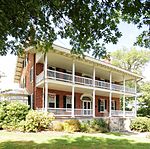Asheville–Buncombe Technical Community College
1959 establishments in North CarolinaAccuracy disputes from June 2022Aviation schools in the United StatesBuildings and structures in Asheville, North CarolinaEducation in Asheville, North Carolina ... and 4 more
North Carolina Community College System collegesTwo-year colleges in the United StatesUniversities and colleges accredited by the Southern Association of Colleges and SchoolsUniversities and colleges established in 1959

Asheville–Buncombe Technical Community College (A-B Tech) is a public community college in Asheville, North Carolina. Established in 1959, the college is one of the oldest in the North Carolina Community College System and serves Buncombe and Madison counties across five different campuses, although students from anywhere may enroll. As of the 2014–15 school year, the curriculum enrollment was 10,070 and continuing education enrollment was 14,053 students. As of 2019–20, the college is the seventh largest in the North Carolina system and the largest in Western North Carolina. A-B Tech offers more than 120 degrees, diplomas, and certificates.
Excerpt from the Wikipedia article Asheville–Buncombe Technical Community College (License: CC BY-SA 3.0, Authors, Images).Asheville–Buncombe Technical Community College
Victoria Road, Asheville
Geographical coordinates (GPS) Address Nearby Places Show on map
Geographical coordinates (GPS)
| Latitude | Longitude |
|---|---|
| N 35.57 ° | E -82.5541 ° |
Address
Asheville-Buncombe Technical Community College
Victoria Road 524
28801 Asheville
North Carolina, United States
Open on Google Maps











